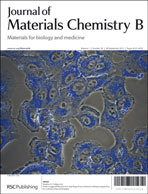A comprehensive method combining polymerization-induced colloid aggregation, silica coating, and high-temperature calcination is developed for the preparation of micro-sized magnetic colloidal nanoparticle cluster/silica (CNC/silica) microspheres. The silica shell stabilizes the inner micro-sized γ-Fe2O3 nanoparticle clusters without phase transformation during high-temperature calcination instead of acting as anti-sintering agents. Their morphologies and inner structures are observed by scanning electron microscopy (SEM) and transmission electron microscopy (TEM). The material characteristics are investigated by Fourier transfer infrared (FTIR) spectroscopy, thermogravimetric analysis (TGA), powder X-ray diffraction (XRD) and vibrating-sample magnetometer (VSM). The biocompatibility and MRI enhancement effect of CNC/silica microspheres are also evaluated by MTT assay and MRI imaging. The prepared CNC/silica microspheres are narrow-dispersed with a wide size range of 1.8 μm to 5.0 μm. These microspheres also have the advantages of higher saturation magnetization (61.38 emu g−1), easily modifiable surfaces, good biocompatibility, high cell-label efficiencies, and significantly enhanced T2 effect in MRI, indicating their various potential applications in biomedical fields.

You have access to this article
 Please wait while we load your content...
Something went wrong. Try again?
Please wait while we load your content...
Something went wrong. Try again?


 Please wait while we load your content...
Please wait while we load your content...